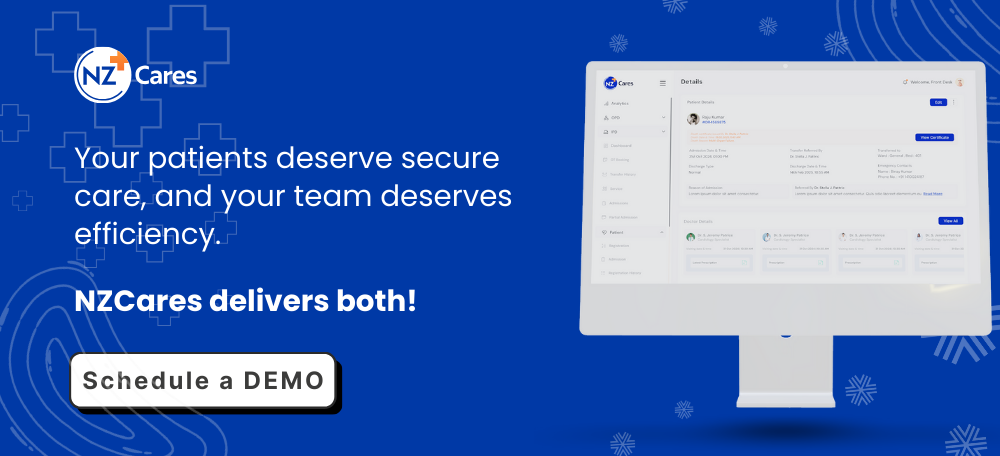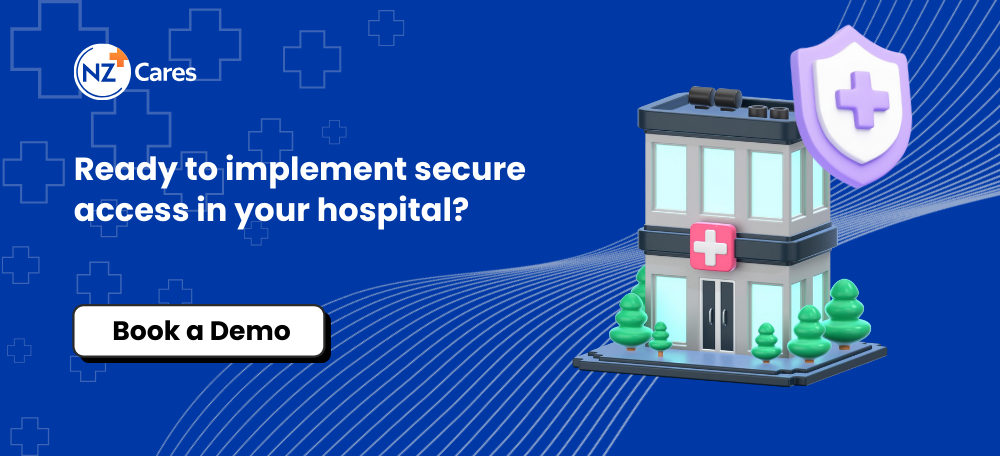In hospitals, one misstep in data access can expose deeply personal medical details. As more healthcare software shifts to digital platforms, the need for airtight data protection has become a top priority.
From electronic medical records to diagnostic histories, the amount of sensitive information stored across networks is massive and growing. It is estimated to be 30% of the world’s data volume.

This is where Role-Based Access Control (RBAC) in healthcare application systems comes into play. RBAC allows institutions to assign access based on job responsibilities, reducing the risk of data breaches from within.
A lab technician doesn’t need access to billing records, just as an admin staff member shouldn’t view patient diagnoses. By narrowing access to what’s essential, RBAC creates a controlled, accountable environment. The goal isn’t just to block unauthorized users, it’s to ensure authorized users interact only with relevant data.
One platform taking this approach seriously is NZCares.
Designed as a smart hospital management system, NZCares uses RBAC to safeguard data access across departments.
Before exploring how NZCares applies this model, it’s worth understanding what makes RBAC essential in today’s healthcare set
What Is RBAC?
RBAC wasn’t built for today’s problems but it solves them better than most modern systems.
Born from early computer networks in the 1970s, it was formalized in 1992 by Ferraiolo and Kuhn as organizations demanded smarter ways to control access. Since then, its adoption has spread across industries, becoming a go-to framework for security.

Why does it matter now?
Because digital systems, especially in healthcare, are flooded with users and data. Doctors, nurses, admin staff, labs all need different access levels. That’s where RBAC in healthcare applications systems fits in. It removes guesswork, locks down sensitive data, and gives access only where it’s needed.
Today, most healthcare applications rely on some version of RBAC. It’s efficient, scalable, and makes compliance easier in a field where one wrong click can lead to a breach.
Defining RBAC
Here’s the core idea: RBAC assigns access based on roles not individuals. If your role requires it, you get the permissions. If not, you’re locked out.
A front desk employee can check appointments, not EMRs. A patient might view lab results, not payment dashboards. That’s how hospital management RBAC integration keeps things secure without slowing anyone down.
It’s a rule-based system that understands jobs, not just logins.
How Is It Different from Other Models?
- Discretionary Access Control (DAC):
In DAC, the data owner decides who gets access. It offers flexibility but poses higher security risks. Users might unknowingly give permission to others, making it less reliable in high-risk sectors like healthcare. - Mandatory Access Control (MAC):
MAC follows strict rules enforced by the system. Access is based on predefined classifications (like confidential or top-secret). While secure, it’s rigid and better suited to military or government use cases than fast-paced hospital settings. - Role-Based Access Control (RBAC):
RBAC offers a balance. It’s structured enough to protect sensitive data but flexible enough to adapt to real-world healthcare operations. That’s why RBAC in healthcare applications systems continues to be the preferred model for safeguarding patient data and maintaining regulatory compliance.
Why Hospitals Need RBAC in Their HMS
In healthcare, access is about control. The primary goal of any hospital management system (HMS) or healthcare software is to protect sensitive information across all departments and functions. That includes everything from patient records to internal workflows.
RBAC in healthcare applications systems supports this objective by enforcing access rules that are both precise and scalable.
What makes RBAC stand out in healthcare software is its smart design. It balances policy neutrality with the principle of least privilege. RBAC has also proven to be cost-effective, particularly for hospitals navigating complex compliance rules and expanding digital ecosystems.
Confidentiality & Trust
Hospitals handle some of the most personal data people will ever share like lab results, diagnoses, billing records, and private notes from doctors. Without proper safeguards, this data is vulnerable to leaks, misuse, or accidental exposure.
RBAC in healthcare applications systems builds digital walls around this information. It limits access to only those whose roles require it. For instance, a nurse doesn’t need to view billing records.
The access separation fosters trust between departments, and between the hospital and its patients.
Operational Efficiency
Confusion and clutter slow down healthcare delivery. When users log into their HMS dashboards, they should see only what matters to their work.
With benefits of RBAC for hospitals, each user is presented with only the modules tied to their role. That reduces training time, minimizes interface errors, and streamlines everyday workflows.
For large hospitals handling hundreds of staff and specialties, this type of access precision turns into real operational gains.
Regulatory Compliance
Laws like HIPAA in the U.S. and GDPR in Europe mandate strict rules on how patient data is accessed, shared, and logged. Hospital management RBAC integration supports these laws by ensuring user actions are trackable and access is limited by default.
When roles are predefined, and permissions are centrally managed, it becomes easier to audit activity and prove compliance. That reduces the risk of regulatory penalties and protects the hospital’s reputation
Smooth Access Management
Every time someone joins, leaves, or changes roles in a hospital, their system access must change too. Without a structured model, that process becomes a constant administrative burden and a potential security hole.
RBAC fixes that by assigning permissions through predefined roles. Admins don’t have to set access for each individual, they just assign the right role.
That makes provisioning and offboarding faster, safer, and less prone to error. Whether it’s IT, HR, or department heads managing access, RBAC simplifies the job across the board.
Tension-Free Scalability
Hospitals evolve. Staff counts rise. New departments emerge. Specialty care expands. With each change, the digital access structure needs to keep pace. RBAC in healthcare software is built for scale.
Whether managing 50 users or 5,000, it adapts to changing team structures without compromising security.
How NZCares Implements RBAC: Real-World Role Mapping
NZCares healthcare application is built to support precision and privacy at every level. One of its standout features is its ability to provide granular access control across user roles.
With powerful access control mechanisms, NZCares strengthens data privacy and regulatory compliance. It supports access restrictions based on roles, specific attributes, and even user-level permissions.
Image: recreate the following image:
Integrated as a smart protection feature, it overcomes complex access challenges with ease. This results in tighter security, and full compliance with healthcare standards like HIPAA and GDPR.
Once roles are defined, the next crucial step is permission mapping. This process involves detailing the data and tools each role should have access to. Clear permission mapping ensures everyone gets exactly what they need to do their job, no risk of data leaks or confusion.
Role-Based Access with NZCares HMS
- Doctor: Interacts with EMRs, prescribes treatments, and navigates diagnostic tools aligned with clinical workflows.
- Nurse: Monitors patient vitals, responds to alerts, and coordinates routine care activities within their designated scope.
- Pharmacist: Reviews prescription data and synchronizes inventory levels to maintain seamless medication management.
- Front Desk Staff: Manages appointment scheduling and billing operations, operating within clearly segmented access boundaries.
- Lab Technician: Conducts sample collection and integrates diagnostic outcomes directly into the system’s lab interface.
- Administrator: Has full 360° system control in managing user roles, assigning permissions, and maintaining access policies across the HMS.
RBAC Integration Steps in HMS Development
As hospitals expand digital operations, data visibility grows exponentially—internally and externally. When legacy CRM systems fall short in controlling this exposure, integrating RBAC becomes less of a feature and more of an operational safeguard.
The steps below offer a strategic approach to embedding RBAC in healthcare applications systems, supported by code-level implementation for development teams.
Step 1. Define Roles & Permissions
Begin by collaborating with key stakeholders from clinical, administrative, to IT, and document all possible user roles within the hospital ecosystem.
Each role should be mapped to its core operational responsibilities. This documentation forms the foundation of your access blueprint.
{
“roles”: [“doctor”, “nurse”, “pharmacist”, “admin”],
“permissions”: {
“view_patient_data”: [“doctor”, “nurse”],
“edit_patient_data”: [“doctor”],
“schedule_appointment”: [“frontdesk”],
“manage_inventory”: [“pharmacist”],
“manage_roles”: [“admin”]
}
}
Step 2. Create a Role-Permission Matrix in Code
Once roles and tasks are outlined, the next move is technical mapping. Using a backend language like Node.js, you can implement a role-permission structure via middleware. Example (Node.js with middleware):
const accessMatrix = {
doctor: [“viewEMR”, “editEMR”, “prescribe”, “viewLab”],
nurse: [“viewEMR”, “monitorVitals”],
frontdesk: [“schedule”, “billing”],
admin: [“all”]
};
function authorize(role, action) {
return accessMatrix[role]?.includes(action) || accessMatrix[role]?.includes(“all”);
}
Step 3: Assign Roles at User Login or Signup
During user onboarding or authentication, the system should attach the correct role profile. Whether it’s through API tokens or session-based authentication, this assignment ensures that every action the user takes aligns with their access tier.
const user = {
id: “u123”,
name: “Dr. Rao”,
role: “doctor”
};
// Attach permissions in session or token
req.session.userRole = user.role;
Step 4: Use Middleware to Enforce Permissions
RBAC middleware acts as the gatekeeper in healthcare software systems. It intercepts API requests and validates if the user’s role has the clearance to perform the action.
function checkPermission(action) {
return function (req, res, next) {
const role = req.session.userRole;
if (authorize(role, action)) {
return next();
} else {
return res.status(403).send(“Forbidden”);
}
};
}
// Route usage
app.get(“/emr/:id”, checkPermission(“viewEMR”), getEMRHandler);
Step 5: Enable Audit Logs
Audit logs ensure tracking of data access or modification, and it should be enabled in your HMS system to exercise the functionality. A schema like the one below helps track who accessed what, when, and from where.
{
“userId”: “u123”,
“role”: “nurse”,
“action”: “viewVitals”,
“patientId”: “p456”,
“timestamp”: “2025-05-15T12:00:00Z”
}
How RBAC Enhances Patient Care
Following a structured RBAC integration, the true value surfaces in patient-facing operations. Better RBAC means better care which means hospital staff operate with clarity, knowing exactly what data they can access without second-guessing.
The presence of role-based access in a hospital’s operational system provides peace of mind. Clinicians no longer worry about sensitive data falling into the wrong hands, and administrators gain confidence in their system’s security posture.
- Less Confusion: Nurses don’t wade through pharmacy menus or admin dashboards.
- More Speed: Doctors access patient records and diagnostic data without delay or digital clutter.
- Fewer Risks: Accidental access to confidential information is eliminated through precise permission boundaries.
- Stronger Trust: Patients feel safer knowing their health data is managed with strict access rules.
Scaling RBAC for Multi-Location Hospitals
As hospital networks grow, so does the complexity of managing access. NZCares simplifies this with built-in multi-location RBAC controls that adapt permissions by location and department.
Each facility operates securely, without overlapping roles or uncontrolled data exposure. Admins can centrally manage access from the main hospital office through NZCares’ dashboard. Role rules are enforced per site.
Which means, a nurse in Hospital A won’t have access to records in Hospital B unless explicitly granted.
This keeps patient data localized, controlled, and fully compliant with healthcare standards.NZCares’ approach helps hospital chains scale confidently, with security and clarity at every level.
Conclusion: Secure, Scalable, and Smart Access with RBAC
In the world of healthcare applications, RBAC does more than just manage access, it builds the foundation for secure and efficient hospital operations.
It ensures the right people access the right information at the right time, all while keeping sensitive patient data safe and systems compliant.
NZCares brings this vision to life with smart features like pre-defined role templates, centralized permission control, and real-time audit trails. This helps hospitals eliminate guesswork, reduce risks, and streamline workflows without compromising security.
For any healthcare organization looking to scale smartly and stay audit-ready, NZCares HMS is built to make that integration seamless, reliable, and future-ready.




